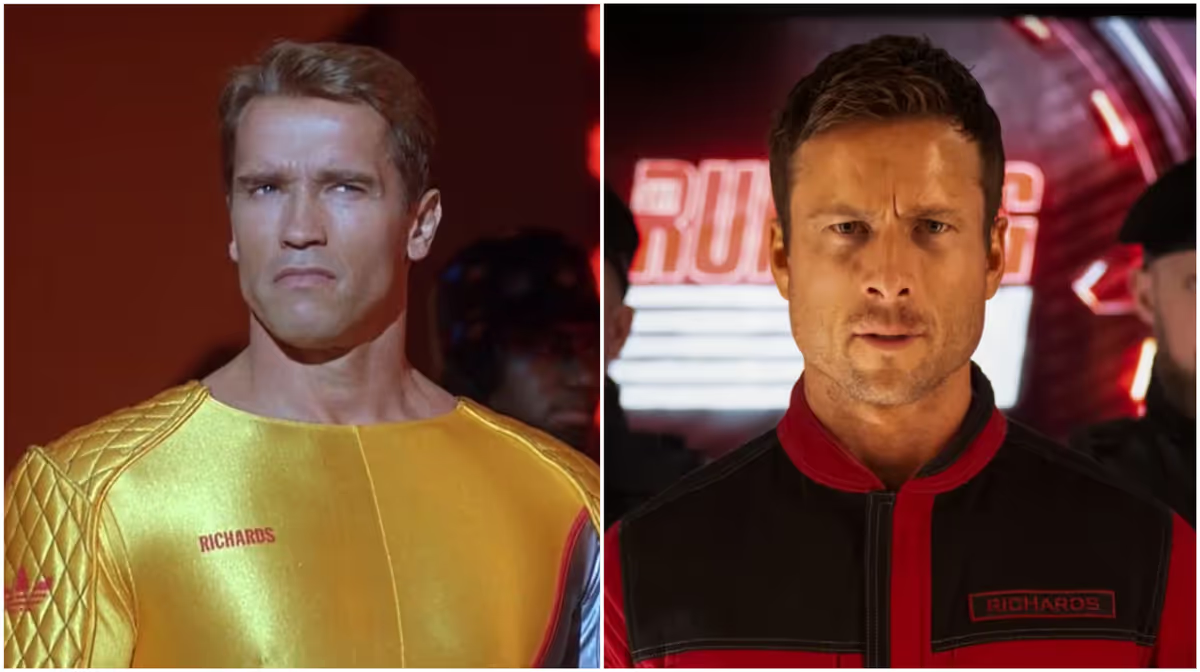The Running Men
Two versions of the same Stephen King novel reflect their eras while speaking to future-present.

I always wanted someone to remake The Stuff.
That’s not to say that Larry Cohen’s 1985 largely forgotten sci-fi/horror comedy isn’t without merit. Foremost, you couldn’t hope for better than Michael Moriarty’s offbeat-edging-on-deranged performance as a private investigator who looks into the bizarre case of a mysterious dessert topping that’s been devouring people from the inside. But Cohen’s take on Invasion of the Body Snatchers has such a brilliant satirical premise—a consumer product that literally consumes the consumer—that you hope for a better follow-through than, say, a scene of Clara Peller, the “Where’s the beef?” lady in Wendy’s commercials, turning up to ask “Where’s The Stuff?” (On the commentary track, Cohen admits the $15,000 that Peller was paid for the cameo was “hardly worth it.”) What might have been an answer to the runaway excess and conformity of the Reagan ’80s turned into a disappointing tease of a film that peak George Romero or Joe Dante would have knocked out of the park.
Most remakes are a mere sprucing-up of intellectual property, updating some past favorite into a close-to-surefire hit for a new generation. And surely Paramount Pictures had that in mind with The Running Man, a new adaptation of a Stephen King (under the Richard Bachman pseudonym) novel that had previously been the source of an Arnold Schwarzenegger vehicle in 1987, when he was in the middle of a (bulky) arms race with Sylvester Stallone. While pedants are correct to point out that “remake” isn’t the perfect term to describe two versions of the same novel, the new film, co-written and directed by Edgar Wright, feels like a response to the old one. There’s no motivation here to recapture the magic of a mediocrity that opened to middling reviews and ho-hum box office. But the smattering of good ideas in the ’87 film are ripe for development and the compromises that dogged its production can be ironed out. It’s a rare opportunity to do the same thing better.
Consider this small but telling distinction: In the ’87 version, Ben Richards (Schwarzenegger), a military captain framed for opening fire on unarmed protestors, draws the attention of Damon Killian (Richard Dawson), the host of The Running Man, a hit game show in a 2017 America where television serves as the propaganda arm of a brutal authoritarian government. Killian catches a glimpse of Richards on the CCTV footage where he’s leading a prison breakout. What he sees is, well, Arnold Schwarzenegger, an eye-catching physical specimen who could feasibly challenge the “stalkers” tasked with hunting him down for the edification of a live television audience. It would do the ratings good for a contestant like Richards to put up a fight, even though the show is rigged to have no winners.
In the new film, which Wright wrote with his Scott Pilgrim vs. the World partner Michael Bacall, Richards isn’t a soldier but a laborer played by Glen Powell, who’s certainly physically capable, but isn’t cast for his brawn alone. Richards auditions for the show like everyone else, queuing up at a network that offers a whole suite of violent reality shows where poor people can risk maiming or death for a quick buck. Richards doesn’t even want to be on The Running Man, because the other shows have a higher survival rate and all he wants is enough money to pay for proper medication for his sick child. But Richards has no other recourse because he’s been blacklisted for his role in unionization efforts at his blue-collar factory job.
Much like the Killian of the ’87 film, the Killian of Wright’s version, now an ultra-powerful producer rather than a host, casts Richards based on a piece of footage that attracts his attention. Only here it’s not Richards’ body that wins him over—he hasn’t yet done any of the physical trials involved in the casting process—but his working-class fury. Killian doesn’t yet see the potential for Richards as the spark for a proletariat revolution, but as someone whose righteous anger can be bottled up and used to suppress the lower classes. They’re angry, too, but the art of television in this dystopian environment is to keep them angry at each other and deepfake technology makes that a snap. The revolution can be immolated by its own spark.
This post is for paying members only
Sign up now to read the post and get access to the full library of posts for subscribers only.
✦ Sign up